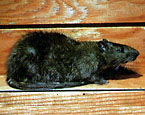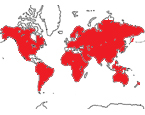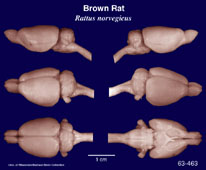|
Brown
Rat (Laboratory)
(Rattus norvegicus) #63-463 |
||||
|
|
Physical
characteristics and distribution
|
|
R. norvegicus a rather large member of the mouse family. On average, these rats reach nearly 400 mm nose-to-tail, and weigh 140 to 500 g. Males are usually larger than females. In natural populations, these rats are covered with coarse, brownish fur (sometimes splotched with black or white hairs) on their dorsal surface, which usually lightens to a gray or tan color nearing the underside. Various strains of these rats bred in captivity may be white, brown, or black. The ears and tail are bald. The length of the tail is shorter than the length of the body. Molars are lophodont and the dentary is 1/1-0/0-0/0-3/3. The ears of Norway rats are typically shorter than those of related species. Although not technically a seasonal breeder, a mating increase occurs in the warmer months of the year. An average female is capable of giving birth approximately seven times per year. Around 18 hours after giving birth, females experience postpartum estrus, and mate again. This reproductive function is responsible for the huge birthrates, which can reach 60 young each year per female. After a short gestation period of 22 to 24 days, the litter of approximately 8 pups is born. The young are very small and underdeveloped. It takes 14 to 17 days for the young's eyes to open. Newborns weigh an average of 5 grams and are milk-fed until weaning occurs at 3 to 4 weeks, and the young then leave the nest. Mostly nocturnal or active at dusk, they go about digging burrows, foraging for food, and preparing nests during these hours. Often, these rats take up residence in areas near water. They are excellent swimmers, and are often referred to as "water rats". They are excellent foragers. Using their sense of smell and touch, they are able to survive quite easily given that there is a steady supply of any type of food. In metropolitan areas, they survive mainly on discarded human food, and anything else that can be eaten without negative consequences. Because of their foraging habits, they act as seed dispersers. Their burrows also tend to aerate the soil. In the wild, Rattus norvegicus is preyed on by any number of carnivorous mammals, birds, and reptiles. Humans also kill very large numbers of these animals as pests. However, they are also one of the most studied animals in science. The species has provided us knowledge to the cures of diseases, workings of the brain, and effects of various substances on the mammalian body. Original distribution assumed to be SE Sibera, N China, and Hondo region (islands of Honshu, Shikoku, and Kyushu) of Japan, but introduced worldwide where it is more common in colder climates of higher N and S latitudes; in warmer regions and tropics restricted to habitats highly modified by humans (e.g. sewers, buildings, wharves, breakwaters, ports, and larger cities). Considered extinct in Norway. |
|
Description
of the brain
|
|
Animal
source and preparation
|
|
|
List of Specimens | Explore Collections | Brain Sections | Brain Evolution | Brain Development | Brain Circuitry | Brain Functions | Location and Use | Related Web Sites | Contact Us | Search MSU Database | Personnel | Home



